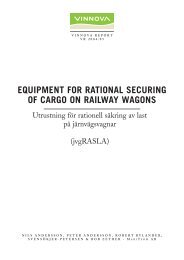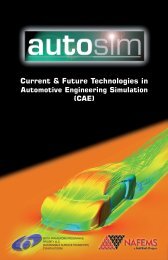WP3: Rail Passenger Transport - TOSCA Project
WP3: Rail Passenger Transport - TOSCA Project
WP3: Rail Passenger Transport - TOSCA Project
Create successful ePaper yourself
Turn your PDF publications into a flip-book with our unique Google optimized e-Paper software.
It should be noted that it is not for sure that all these changes in technology will really be<br />
implemented: At this stage they will only be studied in the context of their potential of<br />
reducing energy use and GHG emissions.<br />
Table 3-1<br />
Examples of changes until 2025, in relation to reference trains.<br />
High-speed Intercity Local city<br />
or regional<br />
Aerodynamic drag - 16 % - 21 % a<br />
Seats per metre of train + 9 % +22 % a + 0 %<br />
Train mass per metre of train - 0 % - 4 % b - 7 % b<br />
Per cent of energy recovery at braking c 75 % to 84 % (2050) 44 % to 72 % (2050)<br />
Energy loss in power systems, per car e - 18 % - 18 %<br />
Energy use for auxiliary and comfort e - 18 % - 18 %<br />
Eco-driving<br />
Speed profile smoothing and coasting before<br />
braking, within a time margin of 3 % d<br />
Increase in top speed 15 % 26 % 12 %<br />
__________________________________________<br />
a Including transition from locomotive-hauled electric trains to multiple units.<br />
b 1/3 of total reduction of tare train mass (until 2050) is estimated to be introduced as state-of-the-art on new trains<br />
until 2025, while 2/3 is introduced in the period 2025–2050.<br />
c In relation to the theoretically possible amount after energy losses, air resistance and rolling resistance, braking<br />
only with electric regenerative brakes. Note that it is assumed that also the reference “state of the art” case have a<br />
substantial average amount of energy recovery in electric rail services, which is not the case in all recent rail<br />
operations. The average real improvement in relation to the present situation for new trains could therefore in<br />
some cases be larger.<br />
d<br />
Driving style is adjusted until 3 % of time-tabled time is used. Usually the total time margin is in the order of 10<br />
%. The use of 3 % of time-tabled time for Eco-driving is an average, sometimes it can be done, sometimes not and<br />
sometimes more, depending on the actual time-keeping situation for the actual train.<br />
e As an example, energy efficiency in the train is originally 82 %, i.e. losses are 18 %. With 18 % reduction of<br />
losses (until 2025) the resulting energy efficiency increases to 85.2 %. In similar way energy efficiency of the<br />
railway’s supply system is increased from 91 % to 92.6 % until 2025. In the very long term (until 2050) energy<br />
losses are assumed to be reduced by 30 %.<br />
Deliverable D4 – <strong>WP3</strong> passenger 15
















